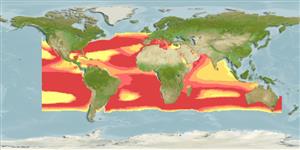>
Lampriformes (Velifers, tube-eyes and ribbonfishes) >
Lophotidae (Crestfishes)
Etymology: Lophotus: Greek, lophos = crest (Ref. 45335).
Eponymy: Bernard Germaine Etienne de la Ville, Comte de Lacépède (also spelled La Cepède) (1756– 1825), was a French naturalist and politician. [...] (Ref. 128868), visit book page.
Issue
Species spelling Eschmeyer, pers. comm.
Environment: milieu / climate zone / profondeur / distribution range
Écologie
marin bathypélagique; océanodrome (Ref. 51243); profondeur 0 - 92 m (Ref. 36608). Deep-water; 51°N - 45°S, 130°W - 158°E
Nearly worldwide in warmer seas. Western Atlantic: Florida in USA to Brazil (Ref. 7251). Eastern Atlantic: western Mediterranean, off Portugal, Madeira and off Canary Islands; also South Africa (Ref. 4165). Western Indian Ocean: recently recorded from Reunion (Ref. 53568). Eastern Pacific: southern California, USA (Ref. 6740). Also reported from Australia (Ref. 9563).
Taille / Poids / Âge
Maturité: Lm ? range ? - ? cm
Max length : 200 cm TL mâle / non sexé; (Ref. 4165); common length : 100.0 cm TL mâle / non sexé; (Ref. 3397)
Épines dorsales (Total) : 0; Rayons mous dorsaux (Total) : 206 - 263; Épines anales: 0; Rayons mous anaux: 5 - 20; Vertèbres: 124 - 153. Head and body silvery in color and possibly with silvery spots; fins red (Ref. 4165).
Body shape (shape guide): elongated.
A rare (Ref. 4165), oceanic, mesopelagic species. Occasionally stranded in shallow water (Ref. 9563). Capable of discharging a black ink from an ink-sac in the cloaca when alarmed. Adults feed on fishes (anchovies) and squids (Ref. 6740). Oviparous, with planktonic eggs and larvae (Ref. 36608). Found in stomachs of tunas (Ref. 2850).
Life cycle and mating behavior
Maturité | Reproduction | Frai | Œufs | Fécondité | Larves
Palmer, G., 1986. Lophotidae. p. 734-735. In P.J.P. Whitehead, M.-L. Bauchot, J.-C. Hureau, J. Nielsen and E. Tortonese (eds.) Fishes of the north-eastern Atlantic and the Mediterranean. UNESCO, Paris. Vol. 2. (Ref. 6740)
Statut dans la liste rouge de l'IUCN (Ref. 130435: Version 2025-1)
Menace pour l'homme
Harmless
Utilisations par l'homme
Pêcheries: sans intérêt
Outils
Articles particuliers
Télécharger en XML
Sources Internet
Estimates based on models
Preferred temperature (Réf.
123201): 15.2 - 26.9, mean 22.1 °C (based on 1116 cells).
Phylogenetic diversity index (Réf.
82804): PD
50 = 0.5938 [Uniqueness, from 0.5 = low to 2.0 = high].
Bayesian length-weight: a=0.00389 (0.00180 - 0.00842), b=3.12 (2.94 - 3.30), in cm total length, based on all LWR estimates for this body shape (Ref.
93245).
Niveau trophique (Réf.
69278): 4.5 ±0.67 se; based on food items.
Fishing Vulnerability (Ref.
59153): Very high vulnerability (90 of 100).
🛈
